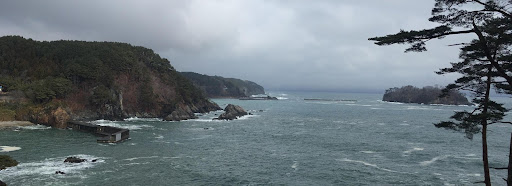
From a pretty early age I recognized that all adventure stories (Treasure Island, The Call of the Wild) started by going through the door and getting out of the house. And in a great many of them (Narnia, The Hobbit) that ment walking. Usually a long ways.
Hiking was clearly the simplest rout to adventure and in middle school I became a scout and learned to camp and backpack. But I know that I couldn’t keep up with “Strider”, from the Lord of the Rings, or even David Balfour from Kidnapped unless I was in better shape. So in high school I started running. The problem with running was that I became addicted to competition and no longer had time to hike!
This past decade I have tried to balance these two passions. Most of the time I find them complimentary. But sometimes I have to actively put the running shoes away, strap on the boots and hit the trail. Hiking really is not just a slow run, it is its own creature.
This Spring found me on trail in Japan.
Since 1975, when I take a long hike, or paddle trip, or bike tour, I usually keep a journal. In recent years I have typed up that journal afterwards, with additional maps and photographs, and posted it on my website. The link for this trek is at the end of this article. For this trip, that write-up became pretty long, there are so many cultural things beyond the trail that I needed to explain. But this article is written for runners, and so I’m going to stick to the trails and two of my favorite days. But, of course, they wouldn’t make much sense if I don’t give you some context.
I went to Japan to visit my old friend Bill. Bill was on my cross-country team in high school, nearly fifty years ago. Since then he has moved all over the world (Chicago, Russia, Turkey, Korea and now Japan) and I have moved all over New Hampshire (Dover, Durham and Hanover) and occasionally, somehow we cross paths. Now it was my turn to travel.
Japan seems like such a long trip (11 times zones), so if I’m going that far I want to spend some time. Bill and his wife are working, so I proposed spending three weekends with them, and then spending Monday to Friday on trail.
—————–
The first week I hiked five days on the “Nakasendo”. The word Nakasendo translates as “The Middle Mountain Path” or “Road” and parts of it probably date to the misty dawn of Japanese time. However the Nakasendo by that name, dates to about 1600. At that time the Emperor was in Kyoto (the Capital) and the Shogun, the real center of power was in Tokyo (Eastern Capital) and everybody else was on the Nakasendo shuffling back and forth between those two.
Along the Nakasendo there developed a series of “post-towns”; stables for messengers to trade horses, and ryokans (inns) for the travelers. The Nakasendo was one of the easier routes through the mountains, which was a good thing if you were traveling four hundred years ago. But it has its down side now. Since it is still the easiest way to get through some narrow valleys, the trail sometime is a sidewalk on the edge of a highway.
Two kilometers along a busy 2-lane highway, then 2-3 km on country lanes, a kilometer through a village (valley villages are long and narrow) and then a few kilometers through a forest of cypress or bamboo. One of my favorite sections was on the second day where the trail went up and over the Torii pass, whereas the road and the train line took a tunnel underneath.
That morning I started at a very old, very traditional ryokan where they had filled me with fish, lotus root tempura and a lot of other tasty things that I didn’t know what they were. And, of course ocha (green tea). I had eaten breakfast wearing a yukata (traditional robe), but then switched into my walking clothes, including an under layer, because it is sleeting outside.
The main street of Naraijuku (population ~2,000) is empty and wet. At the end of the street, just before starting the climb to the Torii Pass is a Shinto shrine, one last place to acquire good luck before starting the climb. It was shortly after this that the weather changed to snow and I met an English couple who have turned back from the hike. “If you slip and twist an ankle, no one will find you”, they tell me. I reassure them that I have been walking in 10cm/4inches of snow (or more) all winter. I think to myself, if one of them fell, I would hope that the other one would go and fetch help.
Most of the trail is under snow, but occasionally, through the slush I can see that I am on flag stones. Much of the Nakasendo was paved with stone hundreds of years ago, so walking it is similar to walking on an ancient Roman Road in Europe. Up and up to the pass, and the snow gets deeper — which makes it a lot more like New Hampshire at this same season — early March.
At the top is “Emperor Meiji’s Resting Place”. It should be a good view down the Kiso Valley and to Mt. Ontake, one of the sacred mountains. Today it is a good view of the inside of a snow cloud. Snow is better than rain, it dosen’t soak in and chill you quite as much.
Just beyond the pass I met the only other walkers I saw on this mountain, a group of Australians, and one women from Connecticut. During the six rainy days of my walk I saw more Australians (six) than Japanese (two).
A “Torii” usually refers to a gateway, and in particular the traditional Japanese arch – with a double cross-bar – that are at the entrances of Shinto shrines. There is an arch and shrine a few hundred meters from the pass. No one else was there. In the snow and wet mist it seems almost mystic. And just beyond it is a stone monument to Basho – the famous haiku poet.
Higher than a skylark
Taking a rest
This mountain pass
I too take a rest and then head down. Past the chestnut grove with legends of forest childern, and then down into the next post-town.
I walked 18miles/30km that day with nothing as beautiful as the pass. But every turn and village is full of something new. Like walking on a sidewalk next to a highway through a long tunnels. Trucks don’t roar in tunnels – they thunder!
Finally I’m into Fukushimajuku, also called Kiso-Fukushima, (because train stations have to have unique names, but towns don’t) and to tonight’s room. I’m in a small apartment above an equipment shed of an organic herb farm!
—————–
On the second week I hike on the Michinoku Coastal Trail, three hundred miles north of Tokyo. If you take the Shinkansen – the Bullet Train – it is easy to get there.
Where as the Nakasendu is a truly ancient road, the Michinoku is a truly new trail. After the 2011 tsunami, which devastated this region, the Japanese government wanted to pump money into the area to rebuild the communities. It also wanted to move people out of harms way. So they aggressively built up the national park system on this coast.
The word “Fukkō” in Sanriku Fukkō Park means “reconstruction” and sometimes it is even called “The Reconstruction Park”. The park itself is a patchwork of land, a headland here, a cove there, some of which were park lands before the tsunami. But in 2012, to try and give cohesion to the whole system, they started building a 1,000 kilometer trail. The Michinoku is definitely a work in progress, parts are along roads, parts on forest lands, and within the park land on dirt (and snow).
Before I left the Upper Valley I had joined a Friends of the Michinoku Facebook group, and asked them, “If I had limited time, what section should I hike?” This was the most recommended section. But also the most rugged, the most vertical.
The third day of this hike is almost all within the park and most of it on dirt; 25km/15miles and 1200meters/4,000ft of elevation. This morning the sun rose across the Pacific, broke into my room and woke me up. This was the first dry (ish) day in a week. When I left the ryokan, it was not raining or snowing! The walk started next to a sandy beach and the day is all smiles.
I entered the park and left the road at Cape Bentenzaki. This cape is the least of the capes I’ll cross today, but it is my first and I am thrilled. Then down into a cove with fishing boats and up the next ridge, a knife edge. I think about the trail guide from Switzerland which said, “not recommended for those given to giddiness”. And then a long drop, hundreds of steps to the next cove.
As I am descending I am looking across the cove trying to figure out how the trail climbs out, but I don’t see a path or stairs. When I get to the water level, a sandy beach, the solution is clear. There is a tunnel, just for hikers, through the headland to the next beach. I had read about this tunnel and so had come prepared with my headlamp, I had even put a new battery in it before leaving New Hampshire. But at some point it must have been left switched on. It is now very, very dim. So I proceed with the light from my iPhone.
The tunnel is about 200 meters long and curves, so you cannot see end to end. It is very dark, but also very simple and so easy compared to the hundreds of steps it replaced. Eventually I emerged onto a little cobbled beach and then almost immediately go into another 200m tunnel.
This time when I’m back in daylight there is a cobbled beach and then a rope ladder stapled to the cliff, maybe 10meters high, and then a long cobbled beach with a pier. Or can I call these a “shingled beach”?
An hour later, while on a series of switchbacks, I come around a corner and interrupt a “Serow”. This is a type of wild mountain goat. To my eye, this one is particularly shaggy. Is this just early spring and it is starting to molt? Or do Serows always look this way? We watch each other for a while, and it allows me to approach to within 6-8 meters before it casually walks off the trail, down a 60-degree incline.
This is a beautiful place, but I cannot really call it Wilderness. On my right the cliff face drops nearly 200 meters to the ocean. Great rollers have come a thousand miles or more across the Pacific to dash themselves on these cliffs. But to my left, a hundred meters inland, are farm fields, some of them plowed and ready for spring planting. Here, on the trail, I’m in a woodland, tramping through 5cm/2inches of snow on a tread way which could be in the upper valley.
There is one more major drop to sea level, down a really steep set of steps, and then a climb up to Cape Kitayamazaki. I lost count of the steps someplace around 500.
The day ended at Cape Kurosaki. Fudai, the local village had mounted a bell here. Above the bell is a heart-shaped plaque which says (in English!),
The bell brings happiness.
Try ringing it
So of course I rang it, even though I was already feeling pretty happy.
For the full Journal, click here.
